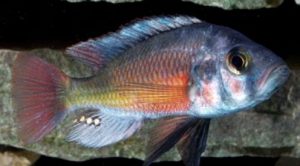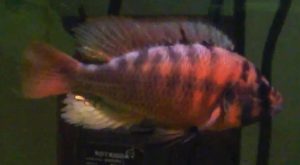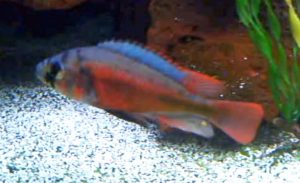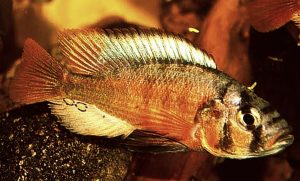The Fire Red Uganda (Haplochromis s. “fire”) or (Paralabidochromis sp. “fire”) is known to tropical fish keeping enthusiasts as the Fire Red Ugandan, and is found in the Northern section of Lake Victoria and Lake Kyoga.
The Fire Red Uganda is a rock dwelling cichlid (mbipi) from the Ugandan shores of Lake Victoria that is easily identified by the grey color below the dorsal fin that runs into the “face” of the fish, and the brilliant crimson red/orange on the lower half of the body.
The caudal fin and the rear of the dorsal fin in adult males is a crimson red to reddish orange color, and the first five rays of the pectoral fins are jet black with the rest of the fin tinged red. The anal fin has three to four yellow to orange “egg spots”.
A black bar, which becomes more pronounced when excited, runs through the eye from the top of the head to the lower jaw and two horizontal black bars cross the head on the forehead.
Females are a much more drab, steel silver to greenish color with the same black barring and are smaller than males.
The Fire Red Uganda cichlid is slightly less aggressive than most other rift valley cichlids and can be housed with other Victoria Lake cichlids and/or Lake Malawi M’buna. Synodontis petricola and others can also be safely housed with them.
In a single species rocky rift valley lake setup, a single male with a harem of 5 or 6 females is a good mix. Adding additional males may cause the dominant male to kill the interloper.
Fire Red Uganda cichlids are best housed in an aquarium of at least 40 gallon capacity, with a sand or fine gravel substrate, some limestone rocks piled up to form a few caves, and some bogwood planted with Anubias barteri
if desired for aesthetics.
Some tropical fish keeping enthusiasts even keep floating plants like Riccia fluitans on the surface for shade, which the fish seem to enjoy.
Fire Red Uganda cichlids need good water quality and some water movement in their tank. A bio-wheel filter or a wet/dry trickle filtration system with 25% to 30% weekly water changes is recommended.
The Fire Red Uganda like many other rock dwelling cichlids is a maternal mouth brooder. A single male with 5 or 6 females will breed without any extra help. The male will constantly display to the females and breed with several. The female will hold the eggs in her mouth up to 3 weeks until hatched and brood them for 3 or 4 more days until the egg sacs of the fry are absorbed.
When released, the fry are able to eat crushed flake food or baby brine shrimp immediately. The fry grow quickly and are for the most part ignored by the parents, but many tropical fish keeping enthusiasts remove the fry or strip them from the female after about 14 to 18 days into a separate rearing tank to reduce the mortality rate.
Fire Red Uganda eat insects, larvae, and small crustaceans in their natural environment. In an aquarium environment they will eat just about anything you give them. A good quality flake food or cichlid pellet along with live, frozen, or freeze dried bloodworms
, krill, mosquito larvae, etc. will keep them healthy. Feed them only once a day and take care not overfeed these cichlids.
The Fire Red Uganda Cichlid (Haplochromis s. “fire”) is occasionally misidentified as Harpagochromis sp. “Orange Rock Hunter”. Although neither species is common in the aquarium trade, they are available online and from specialty tropical fish shops at premium prices.
Minimum Tank Size: 40 gallons
Care Level: Difficult
Temperament: Mildly Aggressive
Aquarium Hardiness: Hardy
Water Conditions: 74-79°F, dH 6-10 °d, pH 7.2-7.5
Max. Size: Males 3.25″ in the wild to 7″ in aquariums
Color Form: Silver, Black, Red, Yellow
Diet: Insectivore
Compatibility: Single species or Victoria/Malawi mbuna
Origin: Lake Victoria, Africa
Family: Cichlidae
Lifespan: 4-10 years
Aquarist Experience Level: Advanced






